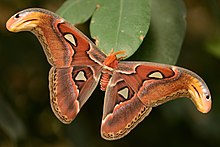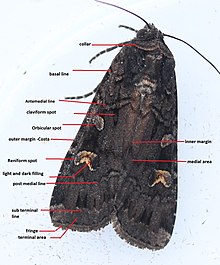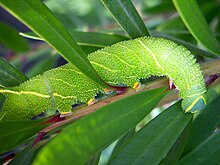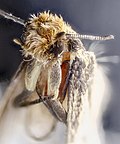Moth
| Moths | |
|---|---|

| |
| Atlas moth,Attacus atlas | |
| Scientific classification | |
| Domain: | Eukaryota |
| Kingdom: | Animalia |
| Phylum: | Arthropoda |
| Class: | Insecta |
| (unranked): | Amphiesmenoptera |
| Order: | Lepidoptera |
| Major divisions | |
| |
Mothsare a group of insects that includes all members of the orderLepidopterathat are notbutterflies.[1]They were previously classified as suborder Heterocera, but the group isparaphyleticwith respect to butterflies (suborder Rhopalocera) and neither subordinate taxon is used in modern classifications. Moths make up the vast majority of the order. There are approximately 160,000speciesof moth,[2]many of which have yet to be described. Most species of moth arenocturnal,although there are alsocrepuscularanddiurnalspecies.
Differences between butterflies and moths

While thebutterfliesform amonophyleticgroup, the moths, comprising the rest of the Lepidoptera, do not. Many attempts have been made to group the superfamilies of the Lepidoptera into natural groups, most of which fail because one of the two groups is not monophyletic:MicrolepidopteraandMacrolepidoptera,HeteroceraandRhopalocera,Jugatae and Frenatae,Monotrysia,andDitrysia.[3]
Although the rules for distinguishing moths from butterflies are not well established, one very good guiding principle is that butterflies have thinantennaeand (with the exception of the familyHedylidae) have small balls or clubs at the end of their antennae. Moth antennae are usually feathery with no ball on the end. The divisions are named by this principle: "club-antennae" (Rhopalocera) or "varied-antennae" (Heterocera). Lepidoptera first evolved during theCarboniferousperiod, but only evolved their characteristicproboscisalongside the rise ofangiospermsin theCretaceousperiod.[4]
Etymology
Themodern Englishwordmothcomes fromOld Englishmoððe(cf.Northumbrianmohðe) fromCommon Germanic(compareOld Norsemotti,Dutchmot,andGermanMotteall meaning 'moth'). Its origins are possibly related to the Old Englishmaðameaning 'maggot' or from the root ofmidgewhich until the 16th century was used mostly to indicate thelarva,usually in reference to devouring clothes.
Caterpillar

Moth larvae, orcaterpillars,makecocoonsfrom which they emerge as fully grown moths with wings. Some moth caterpillars dig holes in the ground, where they live until they are ready to turn into adult moths.[5]
History
Moths evolved long before butterflies; mothfossilshave been found that may be 190 million years old. Both types of Lepidoptera are thought to have co-evolved withflowering plants,mainly because most modern species, both as adults and larvae, feed on flowering plants. One of the earliest known species that is thought to be an ancestor of moths isArchaeolepis mane.Its fossil fragments show scaled wings that are similar tocaddisfliesin their veining.[6]
Economics
Significance to humans

Some moths, particularly theircaterpillars,can be majoragriculturalpests in many parts of the world. Examples includecorn borersandbollworms.[7]The caterpillar of thespongy moth(Lymantria dispar) causes severe damage to forests in the northeastern United States, where it is aninvasive species.In temperate climates, thecodling mothcauses extensive damage, especially to fruit farms. In tropical and subtropical climates, the diamondback moth (Plutella xylostella) is perhaps the most serious pest ofbrassicaceouscrops. Also insub-Saharan Africa,theAfrican sugarcane boreris a major pest of sugarcane,maize,andsorghum.[8]
Several moths in the familyTineidaeare commonly regarded as pests because their larvae eatfabricsuch asclothesandblanketsmade from naturalproteinaceousfibers such aswoolorsilk.[9]They are less likely to eat mixed materials containing some artificial fibers. There are some reports that they may be repelled by the scent of wood fromjuniperandcedar,bylavender,or by other natural oils; however, many consider this unlikely to prevent infestation.Naphthalene(the chemical used inmothballs) is considered more effective, but there are concerns over its effects on human health.
Despite beingcommonly thoughtto be undertaken by all moths,[10][11]only the larvae ofseveral moth specieseat animal fibres, creating holes in articles of clothing, in particular those made of wool. Most species do not eat fabrics, and some moth adults do not even eat at all. Some, like theLuna,Polyphemus,Atlas,Promethea,cecropia,and other large moths do not have mouth parts. This is possible because they live off the food stores from when they were a caterpillar, and only live a short time as an adult (roughly a week for some species).[12]Many species of adult moths do however eat: for instance, many will drinknectar.[9]
Items of fabric infested by clothes moth larvae may be treated by freezing them for several days at a temperature below −8 °C (18 °F).[13]
Some moths arefarmedfor their economic value. The most notable of these is thesilkworm,the larva of the domesticated mothBombyx mori.It is farmed for the silk with which it builds itscocoon.As of 2002[update],the silk industry produces more than 130 million kilograms of raw silk, worth about 250 millionU.S. dollars,each year.[14][15][16]
Not all silk is produced byBombyx mori.There are several species ofSaturniidaethat also are farmed for their silk, such as the ailanthus moth (Samia cynthiagroup of species), the Chinese oak silkmoth (Antheraea pernyi), the Assam silkmoth (Antheraea assamensis), and the Japanese silk moth (Antheraea yamamai).
The larvae of many species areused as food,particularly in Africa, where they are an important source of nutrition. The mopane worm, the caterpillar ofGonimbrasia belina,from the family Saturniidae, is a significant food resource insouthern Africa.Another saturniid used as food is the cavorting emperor (Usta terpsichore). In one country alone,Congo,more than 30 species of moth larvae are harvested. Some are sold not only in the local village markets, but are shipped by the ton from one country to another.[17]
Predators and parasites

Nocturnal insectivores often feed on moths; these include somebats,some species ofowlsand other species ofbirds.Moths also are eaten by some species oflizards,amphibians,cats,dogs,rodents,and somebears.Moth larvae are vulnerable to being parasitized byIchneumonidae.
Baculoviruses are parasitedouble-stranded DNAinsectviruses that are used mostly asbiological controlagents. They are members of theBaculoviridae,a family that is restricted to insects. Most baculovirus isolates have been obtained from insects, in particular from Lepidoptera.
There is evidence that ultrasound in the range emitted by bats causes flying moths to make evasive maneuvers.Ultrasonicfrequencies trigger a reflex action in thenoctuidmoth that causes it to drop a few centimeters or inches in its flight to evade attack,[18]andtiger mothscan emit clicks to foil bats' echolocation.[19][20]
The fungusOphiocordyceps sinensisinfects the larvae of many different species of moths.[21]
Ecological importance
Moths, like butterflies, bees and other more popularly recognizedpollinatinginsects, serve an essential role as pollinators for many flowering plants, including species that bees do not visit. Nocturnal moths fly from flower to flower to feed on nectar during the night much as their diurnal relatives do during the day. A study conducted in the UK found moths dusted with pollen from 47 different plant species, including seven species largely ignored by bees.[22]Some studies indicate that certain species of moths, such as those belonging to the familiesErebidaeandSphingidae,may be the key pollinators for some flowering plants in the Himalayan ecosystem.[23][24]The roles of moths as pollinators have been studied less frequently than those of diurnal pollinators, but recent studies have established that moths are important, but often overlooked, nocturnal pollinators of a wide range of plants.[25][26][27][28]Some researchers say it is likely that many plants thought to be dependent on bees for pollination also rely on moths, which have historically been less observed because they pollinate mainly at night.[29]
Attraction to light

Moths frequently appear to circle artificial lights. The reason for this behavior (positivephototaxis) is currently unknown. One hypothesis is called celestial or transverse orientation. By maintaining a constant angular relationship to a bright celestial light, such as the moon, they can fly in a straight line. Celestial objects are so far away that, even after travelling great distances, the change in angle between the moth and the light source is negligible; further, the moon will always be in the upper part of the visual field, or on the horizon. When a moth encounters a much closer artificial light and uses it for navigation, the angle changes noticeably after only a short distance, in addition to being often below the horizon. The moth instinctively attempts to correct by turning toward the light, thereby causing airborne moths to come plummeting downward, and resulting in a spiral flight path that gets closer and closer to the light source.[30]
Studies have found thatlight pollutioncaused by increasing use of artificial lights has either led to a severe decline in moth population in some parts of the world[31][32][33]or has severely disrupted nocturnal pollination.[34][35]
Noteworthy moths
- Atlas moth (Attacus atlas), one of the largest moths in the world
- Hercules moth (Coscinocera hercules), largest moth in Australia
- White witch moth (Thysania agrippina), the Lepidopteran with the longest wingspan
- Madagascan sunset moth (Chrysiridia rhipheus), considered to be one of the most impressive and beautiful Lepidoptera[36]
- Death's-head hawkmoth(Acherontiaspp.), is associated with the supernatural and evil and has been featured in art and movies
- Peppered moth(Biston betularia), the subject of a well-known study in natural selection
- Luna moth(Actias luna)
- Grease moth(Aglossa cuprina), known to have fed on the rendered fat of humans[37]
- Emperor gum moth(Opodiphthera eucalypti)
- Polyphemus moth(Antheraea polyphemus)
- Bogong moth(Agrotis infusa), known to have been a food source for southeasternindigenous Australians
- Ornate moth(Utetheisa ornatrix), the subject of numerous behavioral studies regarding sexual selection
Moth species that may cause significant economic damage
- Spongy moth (Lymantria dispar), an invasive species pest of hardwood trees in North America
- Winter moth(Operophtera brumata), an invasive species pest of hardwood trees, cranberry and blueberry in northeastern North America
- Corn earwormor cotton bollworm (Helicoverpa zea), a major agricultural pest
- Indianmeal moth(Plodia interpunctella), a major pest of grain and flour
- Codling moth(Cydia pomonella), a pest mostly of apple, pear and walnut trees
- Light brown apple moth(Epiphyas postvittana), a highlypolyphagouspest
- Wax moths(Galleria mellonella,Achroia grisella), pests of bee hives
- Duponchelia fovealis,a new invasive pest of vegetables and ornamental plants in the United States
Gallery
-
Leaf-shaped moth (Pergesa acteus)
-
Giant grey moth (Agrius convolvuli)
-
Oleander hawk-moth or army green moth (Daphnis nerii)
-
Six-spot burnet moths mating (Zygaena filipendulae)
-
Protective silk (or similar material) case (cocoon)
-
A caterpillar ofdeath's-head hawkmoth
-
Mating pair ofLaothoe populi,or poplar hawkmoths, showing two different color variants
-
White-lined sphinx mothin Colorado, United States
-
Closeup of acommon clothes moth
-
Giant silk moth (Adelowalkeria tristygma)
-
Adult emperor moth (Gonimbrasia belina)
-
A moth on a marble floor inKolkata,India
-
Clothes moth, eye
-
Femalerose-myrtle lappet mothhanging on the wooden door
-
A moth on artificial flowers inKolkata,India
See also
- Baculovirus
- Clothing moth
- Comparison of butterflies and moths
- List of moths
- Lepidopterism
- Pollination
- Mothman
References
- ^Heppner, J.B. (2008). "Moths (Lepidoptera: Heterocera)". In Capinera, J.L. (ed.).Encyclopedia of Entomology.Springer, Dordrecht. pp. 2491–2494.doi:10.1007/978-1-4020-6359-6_4705.ISBN978-1-4020-6242-1.
- ^"Moths".Smithsonian Institution.Archivedfrom the original on 2 July 2018.Retrieved12 January2012.
- ^Scoble, MJ 1995. The Lepidoptera: Form, function and diversity. Oxford, UK: Oxford University Press; 404 p.
- ^Kawahara, Akito Y.;Plotkin, David; Espeland, Marianne; Meusemann, Karen; Toussaint, Emmanuel F. A.; Donath, Alexander; Gimnich, France; Frandsen, Paul B.; Zwick, Andreas; Reis, Mario dos; Barber, Jesse R. (5 November 2019)."Phylogenomics reveals the evolutionary timing and pattern of butterflies and moths".Proceedings of the National Academy of Sciences.116(45): 22657–22663.Bibcode:2019PNAS..11622657K.doi:10.1073/pnas.1907847116.ISSN0027-8424.PMC6842621.PMID31636187.
- ^Darby, Gene (1958).What is a Butterfly.Chicago:Benefic Press.p. 41.
- ^Hoyt, Cathryn."Evolution of Moths and Butterflies".Chihuahuan Desert Nature Center.Archived fromthe originalon 6 January 2014.
Studying the evolution of butterflies and moths is challenging, since fossils are so rare. But the few Lepidopteran fossils that exist, captured in amber or compressed in fine-grained rocks, show an astonishing amount of detail. The earliest Lepidopteran fossils appear in rocks that are about 190 million years old. These tiny fragments of scaled wings and bodies clearly indicate that moths evolved before butterflies.
- ^Fernandez-Cornejo, Jorge; Caswell, Margriet (April 2006)."The First Decade of Genetically Engineered Crops in the United States"(PDF).ers.usda.gov.USDA.Economic Information Bulletin Number 11. Archived fromthe original(PDF)on 14 June 2010.
- ^Conlong, D.E. (February 1994). "A review and perspectives for the biological control of the African sugarcane stalkborer Eldana saccharina Walker (Lepidoptera: Pyralidae)".Agriculture, Ecosystems & Environment.48(1): 9–17.Bibcode:1994AgEE...48....9C.doi:10.1016/0167-8809(94)90070-1.
- ^abScott, Thomas (1995).Concise Encyclopedia BiologyArchived12 January 2014 at theWayback Machine.Walter de Gruyter.ISBN3-11-010661-2.
- ^Cohen, Arianne (January 27, 2010)."When Moths Make a Home in Yours".The New York Times.RetrievedJune 24,2024.
- ^Zwick, Andreas; Luo, Ying (January 5, 2022)."Moths eating your clothes? It's actually their hungry little caterpillars – here's how to get rid of them".CSIRO.RetrievedJune 24,2024.
- ^Konkel, Lindsey (28 July 2012)."7 Things You Don't Know About Moths, But Should".Live Science.Archivedfrom the original on 20 January 2021.Retrieved19 January2021.
- ^Choe, D.-H. (21 June 2016)."How to Manage Pests | Pests of Homes, Structures, People, and Pets | Clothes Moths".ipm.ucdavis.edu.University of California, Davis.Archivedfrom the original on 25 June 2007.
- ^"Table 74. Raw silk: production (including waste)".Food and Agriculture Organization of the United Nations.Archivedfrom the original on 18 March 2008.Retrieved2 October2008.
Table lists worldwide raw silk production 132,400 metric tonnes in 2002
- ^"Silk Exchanges of Tamil Nadu and Andhra Pradesh".Central Silk Board of India. Archived fromthe originalon 7 March 2007.gives silk prices in rupees. Exchange rate is about 50 RS to dollar.
- ^"Silk Worm Farming".Vegan Society. Archived fromthe originalon 19 June 2008.Retrieved2 October2008.
World Raw Silk Production in 1996 is listed as 83,670 metric tonnes
- ^"Some Edible Species".Food-Insects.Archived fromthe originalon 7 November 2014.
- ^Jones, G; D A Waters (2000)."Moth hearing in response to bat echolocation calls manipulated independently in time and frequency".Proceedings of the Royal Society B: Biological Sciences.267(1453): 1627–32.doi:10.1098/rspb.2000.1188.PMC1690724.PMID11467425.
- ^Kaplan, Matt (17 July 2009)."Moths Jam Bat Sonar, Throw the Predators Off Course".National GeographicNews.Archived fromthe originalon 22 August 2009.
- ^"Some Moths Escape Bats By Jamming Sonar".NPR(video). 17 July 2009.Archivedfrom the original on 10 August 2017.
- ^Baral, B (Feb 2017)."Entomopathogenicity and biological attributes of Himalayan treasured fungusOphiocordyceps sinensis(Yarsagumba) ".Journal of Fungi.3(1): 4.doi:10.3390/jof3010004.PMC5715966.PMID29371523.
- ^Fox, Alex."Moths Work the Pollination Night Shift, Visiting Some Flowers Bees Skip".smithsonianmag.Archivedfrom the original on 30 October 2022.Retrieved30 October2022.
- ^"National Mission on Himalayan Studies".nmhs.org.in.Archivedfrom the original on 4 November 2018.Retrieved4 November2018.
- ^Singh, Shiv Sahay (28 October 2018)."Moths are key to pollination in Himalayan ecosystem".The Hindu.ISSN0971-751X.Archivedfrom the original on 28 October 2018.Retrieved4 November2018.
- ^Walton, Richard E.; Sayer, Carl D.; Bennion, Helen; Axmacher, Jan C. (13 May 2020)."Nocturnal pollinators strongly contribute to pollen transport of wild flowers in an agricultural landscape".Biology Letters.16(5). The Royal Society.doi:10.1098/rsbl.2019.0877.PMC7280044.PMID32396782.
- ^Matt McGrath (13 May 2020)."Nature crisis: Moths have 'secret role' as crucial pollinators".BBC.Archivedfrom the original on 13 May 2020.Retrieved13 May2020.
- ^Macgregor, Callum J.; Pocock, Michael J. O.; Fox, Richard; Evans, Darren M. (2015)."Pollination by nocturnal Lepidoptera, and the effects of light pollution: a review".Ecological Entomology.40(3): 187–198.Bibcode:2015EcoEn..40..187M.doi:10.1111/een.12174.ISSN1365-2311.PMC4405039.PMID25914438.
- ^Hahn, Melanie; Brühl, Carsten A. (25 January 2016)."The secret pollinators: an overview of moth pollination with a focus on Europe and North America".Arthropod-Plant Interactions.10(1): 21–28.Bibcode:2016APInt..10...21H.doi:10.1007/s11829-016-9414-3.ISSN1872-8855.S2CID18514093.Archivedfrom the original on 14 March 2022.Retrieved19 September2021.
- ^Kuta, Sarah."Moths are the Unsung Heroes of Pollination".smithsonianmag.Archivedfrom the original on 30 October 2022.Retrieved30 October2022.
- ^"Why Are Moths Attracted to Flame?".npr.org.18 August 2007.Archivedfrom the original on 8 January 2009.Retrieved5 April2018.
- ^van Langevelde, Frank; Braamburg-Annegarn, Marijke; Huigens, Martinus E.; Groendijk, Rob; Poitevin, Olivier; van Deijk, Jurriën R.; Ellis, Willem N.; van Grunsven, Roy H. A.; de Vos, Rob (4 January 2018). "Declines in moth populations stress the need for conserving dark nights".Global Change Biology.24(3): 925–932.Bibcode:2018GCBio..24..925V.doi:10.1111/gcb.14008.ISSN1354-1013.PMID29215778.S2CID205145880.
- ^"The State Of Britain's Moths".butterfly-conservation.org.Archivedfrom the original on 4 November 2018.Retrieved4 November2018.
- ^Boyes, Douglas H.; Evans, Darren M.; Fox, Richard; Parsons, Mark S.; Pocock, Michael J. O. (August 2021)."Street lighting has detrimental impacts on local insect populations".Science Advances.7(35): eabi8322.Bibcode:2021SciA....7.8322B.doi:10.1126/sciadv.abi8322.PMC8386932.PMID34433571.
- ^Macgregor, Callum J.; Evans, Darren M.; Fox, Richard; Pocock, Michael J. O. (12 July 2016)."The dark side of street lighting: impacts on moths and evidence for the disruption of nocturnal pollen transport".Global Change Biology.23(2): 697–707.doi:10.1111/gcb.13371.ISSN1354-1013.PMID27251575.
- ^Knop, Eva; Zoller, Leana; Ryser, Remo; Gerpe, Christopher; Hörler, Maurin; Fontaine, Colin (2 August 2017)."Artificial light at night as a new threat to pollination"(PDF).Nature.548(7666): 206–209.Bibcode:2017Natur.548..206K.doi:10.1038/nature23288.ISSN0028-0836.PMID28783730.S2CID4466564.Archived(PDF)from the original on 27 May 2023.Retrieved13 June2023.
- ^Tait, Malcolm (2006).Animal Tragic: Popular Misconceptions of Wildlife Through the Centuries.Think Books. p. 38.ISBN978-1-84525-015-7.Archivedfrom the original on 6 August 2020.Retrieved24 September2016.
- ^Brundage, Adrienne (23 March 2009), Other Arthropods of Forensic Importance, Texas A&M University, Texas A&M University Forensic Entomology Lecture
![]() Quotations related toMothsat Wikiquote
Quotations related toMothsat Wikiquote
















